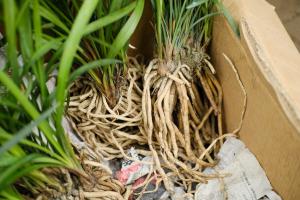A Guide to Identifying Overwatered Aloe Plants
Aloe plants are a popular choice for houseplant enthusiasts because of their sturdy, succulent leaves and low maintenance needs. However, just like any other plant, they can be susceptible to overwatering. In fact, overwatering is one of the most common mistakes made by first time aloe plant owners. So, what does an overwatered aloe plant look like? Here's a guide to help you identify the signs of overwatering and what to do about it.
1. Leaning or wilting stems
One of the first signs of overwatering in an aloe plant is a noticeable change in the stiffness of its leaves or stems. When roots are overwatered, they become waterlogged and can't absorb oxygen from the soil, which causes the stem or leaves to bend or wilt. If you notice your aloe plant leaning to one side or appearing wilted, it might be a sign that you're giving it too much water.
2. Brown or mushy leaves
Another clear sign of overwatering in an aloe plant is brown or mushy leaves. Overwatering can lead to root rot, a condition that occurs when roots are constantly saturated with water and can't dry out. When this happens, your aloe plant will have trouble absorbing nutrients and will start to decay. Brown or mushy leaves may indicate that this process has already started.
3. Yellowing or drooping leaves
Along with brown or mushy leaves, overwatered aloe plants may also have yellowing or drooping leaves. This happens because excess water robs the soil of oxygen, which can cause leaves to turn yellow and eventually fall off. Additionally, overwatering can lead to nutrient deficiency, which can cause leaves to droop or become weak.
What to do about an overwatered aloe plant
If you suspect that your aloe plant is being overwatered, the first step is to stop watering it immediately. Allow the soil to dry completely and check the roots for signs of root rot. If there's any evidence of rot, remove the affected roots and re-pot your aloe plant in a well-draining soil mix.
To avoid overwatering in the future, make sure to allow the soil to dry out completely between waterings. A good rule of thumb is to only water your aloe plant when the soil is completely dry to the touch. Additionally, make sure to use a well-draining soil mix and a pot with drainage holes. This will allow excess water to drain out of the bottom of the pot and prevent it from accumulating in the soil.
In conclusion, overwatering aloe plants is a common mistake that can lead to serious damage if not corrected. Knowing the signs of overwatering and taking action quickly can help you keep your aloe plant healthy and thriving for years to come.

 how many times do yo...
how many times do yo... how many planted tre...
how many planted tre... how many pine trees ...
how many pine trees ... how many pecan trees...
how many pecan trees... how many plants comp...
how many plants comp... how many plants can ...
how many plants can ... how many plants and ...
how many plants and ... how many pepper plan...
how many pepper plan...





























